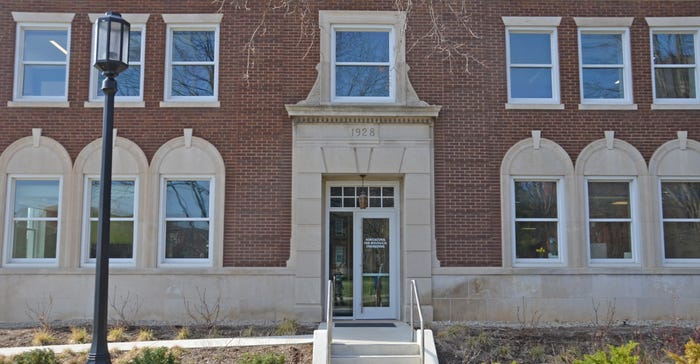
The original Purdue University Ag Engineering Building served students and faculty for nearly a century. Today, the facility has state-of-the-art space to pursue studies and research. A part of the original structure was preserved for historic reasons, but most of the facility is new.
The new Purdue Agricultural and Biological Engineering Building features five floors above ground in the main structure, plus a floor for student and faculty use below ground. The building opened in the fall of 2021, but some labs are still waiting to be equipped.
Recently, Bill Field, Purdue Extension ag safety specialist, provided a private tour of the new facility. Since it’s so massive, this is the first of a three-part series, introducing you not only to the building’s new space, but also to some of its people.
Field arrived at Purdue in the late 1970s and helped develop such important efforts as Breaking New Ground and AgrAbility, both of which extend beyond Indiana’s borders. He was instrumental in the effort to salvage part of the original building and incorporate it into the new structure.
“The architecture is unique, and it is part of the history of the Purdue College of Agriculture and the Department of Agricultural and Biological Engineering,” Field says. “I’m pleased that the administration agreed to incorporate part of the old structure into the new building.”
Meeting student needs
Many current vocational-agriculture teachers across Indiana worked on small engines and learned about basic ag mechanics in an archaic shop space on the first floor of the old building. It was substandard even compared to ag shops in most high schools today. Now, students work in state-of-the art space, with access to high-tech training tools.
Field teaches a class in the basement of the new building. The classroom is equipped with all the technology he needs to get his message across to students. Field still believes in face-to-face instruction.
“We have larger classroom space for bigger classes, and then smaller space if classes are smaller,” he explains. “These spaces allow us to get in front of students and have meaningful discussions.”
Roger Tormoehlen also works with students when he’s not busy developing safety education materials for youth. Both Tormoehlen and Field share new work and storage space dedicated to ag safety efforts. It’s space they didn’t have before, Tormoehlen says.
Tormoehlen also guides students wanting to work toward finding high-tech solutions to modern ag problems. In the past, he advised a team of students who put together an autonomous machine that could spray and fertilize in the field on the go. The new building offers even more, improved space for those kinds of activities, he notes.
Graduate training
Recently, U.S. News & World Report named Purdue’s graduate program in agricultural and biological engineering as the top-ranked graduate school in its field. In fact, both the graduate and undergraduate programs of the department have consistently received top rankings over the past decade, according to Purdue Agricultural Communications.
The new building features open-concept office space for over 100 graduate students, designed to promote collaboration. Until recently, however, most of the space was often empty, due to the lingering impact of COVID-19; many graduate students and faculty members were working from home. Field notes that within the past couple of months, more students and faculty are working in the building.
About the Author(s)
You May Also Like




